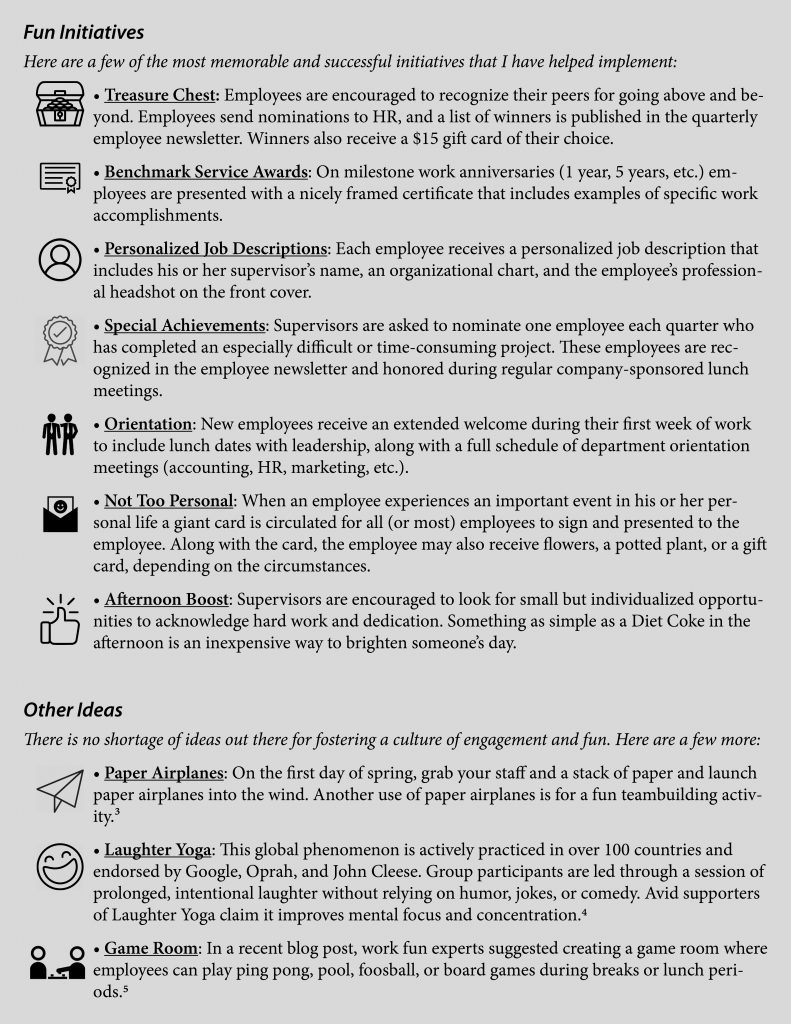Amet Locatio Conductio Operarum: “Fun in the Workplace”
By Jennifer A. Hearne
We spend up to one-third of our lives at work. For some of us, this means we will spend up to 90,000 hours at work during our lifetime. By developing a workplace culture that fosters camaraderie and fun, those 90,000 hours can be spent increasing the quality of employees’ life.
Investing in employee success and workplace fun is analogous to investing in the future of your business. Indeed, countless studies, newspaper articles, and blogs have touted the benefits of employee engagement, which include increased productivity, decreased turnover, and reduced absenteeism.[i] Internal case studies from Apple, Microsoft, Google, and Netflix show a direct link between employee engagement and increased profits.[ii]
At the same time, however, there are potential pitfalls to incorporating fun into a workplace.
Drawing from my experience as House Counsel and Director of Human Resources for a college that emphasized incorporating fun into the workplace, I have a series of ideas about how to foster this without running into trouble.

Why It Works
The above initiatives and ideas only work if there is buy-in from the top. Here are the key ways to achieve that buy-in:
Lead by Example. Senior and mid-level leaders should be actively involved in fun initiatives, with participation included on all manager job descriptions as a “required” job function. For example, leadership could author regular articles in the employee newsletter to promote fun initiatives.
Training. Managers should receive regular training on how to coach and encourage employees, rather than discipline them.
Sincerity. Efforts to help employees feel valued must be perceived as genuine. One way to accomplish this is to make those efforts deliberate and thoughtful rather than “one size fits all.”
Investment. The business must demonstrate its long-term commitment to fun initiatives by allocating significant financial resources toward the development of personalized job descriptions, employee perks, and hiring a dedicated ambassador.
Measuring Results. How employees feel about work is difficult to measure. One effective (but also expensive) way to measure success is through the administration of employee satisfaction surveys. These surveys should be completed on a regular time schedule so that companies can measure whether employee satisfaction is going up or down over time. Tracking employee turnover, employee performance, and absenteeism rates over time can also provide useful metrics.[vi]

Tips to Avoid Pitfalls
There is a risk that, when fun is introduced into the work environment, some employees will interpret this as a license to tell jokes or discuss issues that others may find offensive. Companies should establish clear boundaries to avoid unintentionally creating an environment that breeds harassment or discrimination of any kind.
Simple guidance to supervisors and employees might include the following:
- Poke fun at events, not people;
- Steer clear of discussions about religion and politics;
- Never compromise safety; and
- Don’t lose sight of the work that needs to be done.
A second risk is that, by seeking to introduce fun into the workplace, the business fails to account for the diversity of its employees, thus excluding or alienating some employees. For example, dietary restrictions should be taken into account when planning group meals.
A Worthwhile Investment
As long as a company’s efforts are thoughtful, non-discriminatory and consistent, it’s hard to find a good reason not to pour energy and resources into developing a fun and positive workplace culture. Employees who genuinely feel valued and appreciated are more productive, are absent less often, and are more loyal to your business. Regardless of how many of those 90,000 hours you’ve got left, it’s never too late to start having fun at work. Now seriously, go have fun!

Jennifer A. Hearne’s legal practice with J.A. Hearne Law, PLLC is centered around employment and labor law. When she is not defending clients, drafting employee handbooks, and developing training, Jennifer enjoys boating, skiing, and biking with her family and friends.
[i] Gallup, “Employee Engagement On the Rise in the U.S.” by Jim Harter, August 26, 2018, published in Economy, https://news.gallup.com/poll/241649/employee-engagement-rise.aspx; Harvard Business Review, “Engagement Does More Than Boost Productivity” John Baldoni, July 2013 https://hbr.org/2013/07/employee-engagement-does-more
[ii] Questions and Answers About Fun at Work: https://pdfs.semanticscholar.org/3b34/9a3cd0fad79c80e14b295780409a4b48ce78.pdf ; Non Profit HR, “An Apple is an Apple is an Apple. Employee Engagement: Does Benchmarking Really Have Value?” http://www.nonprofithr.com/wp-content/uploads/2013/02/An-Apple-is-an-Apple-is-an-Apple.pdf; “Steve Jobs’ Legacy: 360 Degree Engagement” http://www.incentivemag.com/Strategy/Engagement/Steve-Jobs–Legacy–360-Degree-Engagement/
[iii] Solving the Puzzles of Teamwork: https://drclue.com/paper-airplanes-for-teambuilding/
[iv] LaughterYoga.org: https://laughteryoga.org/laughter-yoga/application/laughteryoga-in-business/
[v] 25 Ways to Have Fun at Work: https://daringtolivefully.com/have-fun-at-work
[vi] Top 39 Human Resources (HR) Metrics & How to Calculate Them: https://fitsmallbusiness.com/hr-metrics/
 Official Government Website
Official Government Website
